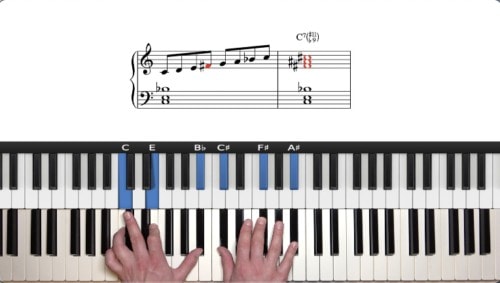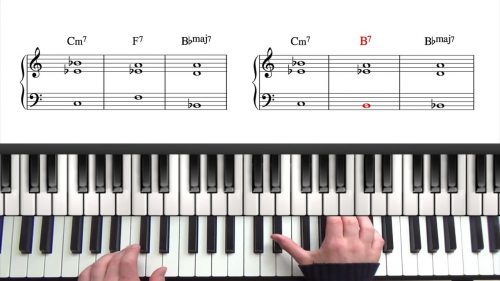Chromatically Descending Dominants
In this lesson we introduce a chromatically descending dominant chord sequence in bars 7 and 8 of the 12 bar blues progression. This approach creates a smooth and distinctive harmonic shift, moving in the opposite direction of the diatonic walk-up covered in the previous lesson.
By the end of this lesson, you’ll have a solid understanding of how to incorporate chromatic dominant chords to create rich tension and resolution in your blues playing.
Chromatic Dominant Reharmonisation
In the 12-bar blues progression, the 7th and 8th bars are a prime spot to introduce interesting reharmonisations. While we previously explored moving upward through diatonic chords (C major, D minor, E minor, etc.), this time we take a chromatic approach with descending dominant 7th chords:

We start with a C major chord and then descend chromatically: C to B7, to Bb7, and finally to A7. Dominant 7th chords create a strong sense of resolution a half step down which is the ‘glue’ that holds this progression together. The final chord A7 is the V of D-7 in bar 9.
Blues Scale Licks and Material
We then explore how to integrate blues scale licks into the chromatically descending dominant sequence. The E minor blues scale can be used effectively over the B7 chord as it shares common chord tones such as the root and the b7. B7 also has a natural tendency to resolve to E minor, making licks from the E minor blues scale a perfect fit to create melodic embellishment:

We also incorporate C minor blues scale licks when playing over the Bb7 chord. The C minor blues scale shares many common tones with Bb7 (root, 9th, 4th, 5th, #5th, and 13th) which makes it well suited for melodic embellishment:

The combination of blues scale licks and chromatically descending dominants creates an interesting harmonic sequence combined with funky blues melodic embellishment.
Practice Tips
-
Alternate between the diatonic walk-up and the chromatic walk-down. These progressions can be used to add variety to repeating choruses.
-
Experiment with the E minor blues scale over the B7 chord, and the C minor blues scale over the Bb7 chord to add melodic interest to the progression.
- Remember that the descending dominant sequence can be played with 2-handed voicings and without melodic embellishment to provide 'breathing space' inside the 12 bar blues form.






